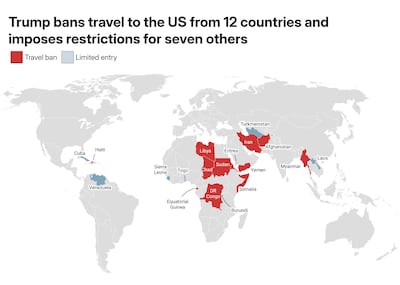US President Donald Trump on Wednesday banned citizens of 12 countries from entering the US and imposed visa restrictions on seven others.
The move is similar to what many called the “Muslim ban” that he imposed in 2017 at the start of his first term.
Which countries are affected by the travel ban?
Mr Trump's executive order denies entry to all travellers from Afghanistan, Myanmar, Chad, Congo, Equatorial Guinea, Eritrea, Haiti, Iran, Libya, Somalia, Sudan and Yemen. Citizens of Burundi, Cuba, Laos, Sierra Leone, Togo, Turkmenistan and Venezuela will not be able to apply for tourist or student visas or apply for permanent residence in the US.
Mr Trump said the list could be revised and new countries could be added.
Why was the travel ban imposed?
The White House said national security and visa overstays were the primary reasons for instigating the ban.
In a video posted on X, Mr Trump said the US “cannot have open immigration from any country where we cannot safely and reliably vet and screen” travellers.
“We will not allow people to enter our country who wish to do us harm,” he said.
He opened his remarks by mentioning the recent “terror attack” attack in Boulder, Colorado. An Egyptian man has been charged with throwing Molotov cocktails at a demonstration in the city that was calling for the release of Israeli hostages held by Hamas in Gaza.
Mr Trump said that attack “underscored the extreme dangers posed to our country by the entry of foreign nationals who are not properly vetted, as well as those who come here as temporary visitors and overstay their visas”.
However, Egypt is not included in the travel ban.
According to a White House fact sheet, the countries listed in the ban have high rates of citizens overstaying their visas and remaining in the US illegally. In some cases, the nations are not co-operative when US authorities try to send people back home.
For example, Myanmar and Chad have overstay rates of more than 55 per cent for several visa categories, the White House said.
“The high visa overstay rate for 2022 and 2023 is unacceptable and indicates a blatant disregard for US immigration laws,” the fact sheet reads.

When does it take effect?
The travel restrictions will go into effect from Monday, June 9, unlike the 2017 ban. That was imposed with immediate effect and resulted in chaos at airports in America and around the world as travellers from the affected countries were turned back.
Are there exceptions?
The new ban will not apply to current green card holders, people with existing US visas or to athletes travelling to the US for the football World Cup next year and the 2028 summer Olympics in Los Angeles. Afghans eligible for special immigrant visas for helping the US during the war in Afghanistan are also exempted.
What was the 2017 travel ban?
The previous travel ban imposed by Mr Trump was issued by executive order on January 27, 2017, a week after he took office. Titled Protecting the Nation from Foreign Terrorist Entry into the United States, the order was applied to seven Muslim-majority countries – Iran, Iraq, Libya, Somalia, Sudan, Syria and Yemen, although Iraq was later dropped from the list.
It blocked the entry of citizens of these countries for 90 days and the entry of all refugees for 120 days – indefinitely in the case of Syria – pending a review of the admission process. The ban led to protests and its enforcement was blocked by legal challenges, leading to several revisions until the US Supreme Court upheld an amended version in June 2018.
Faced with accusations that the choice of countries targeted indicated a bias against the Muslim community, the Trump administration said those nations had already been subject to restrictions under his predecessor, Barack Obama.
President Joe Biden revoked Mr Trump’s travel ban and related orders immediately after taking office on January 20, 2021.
